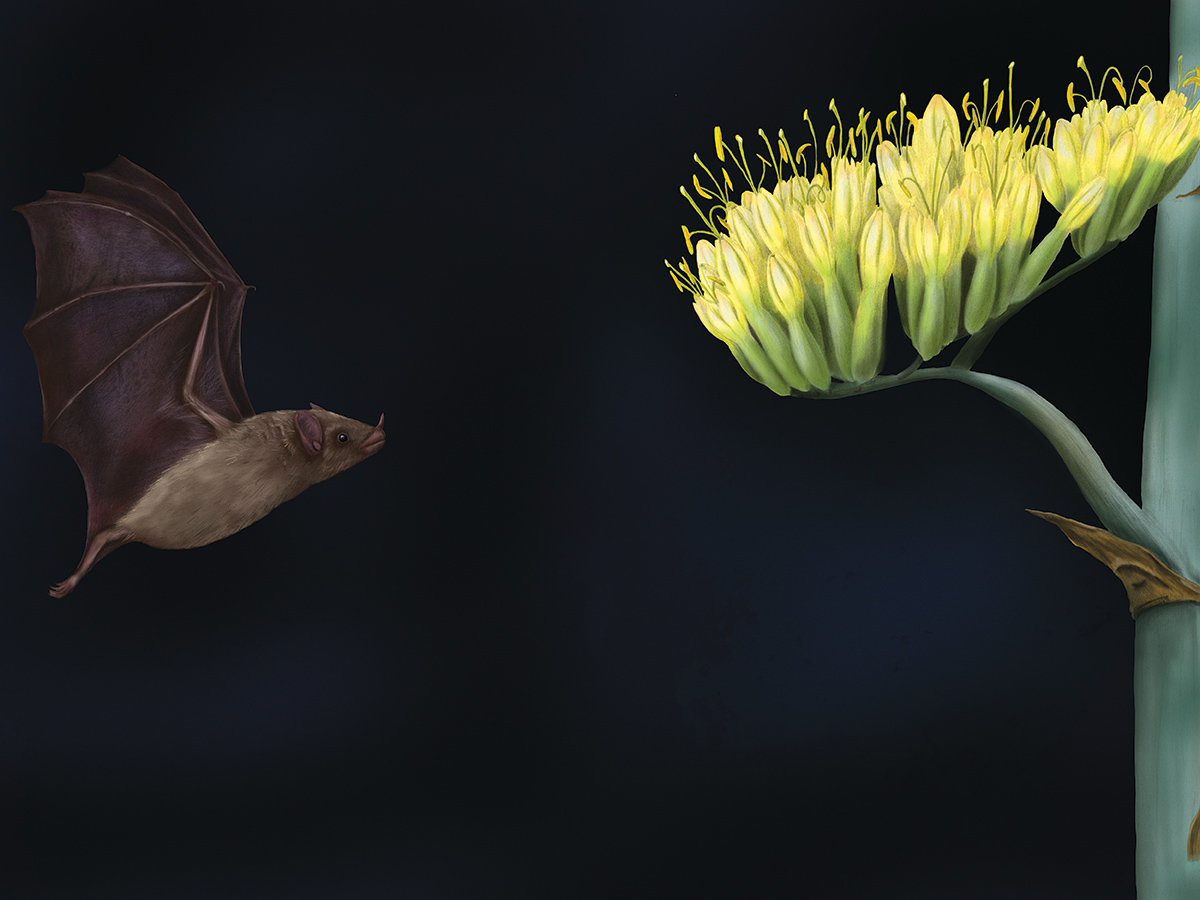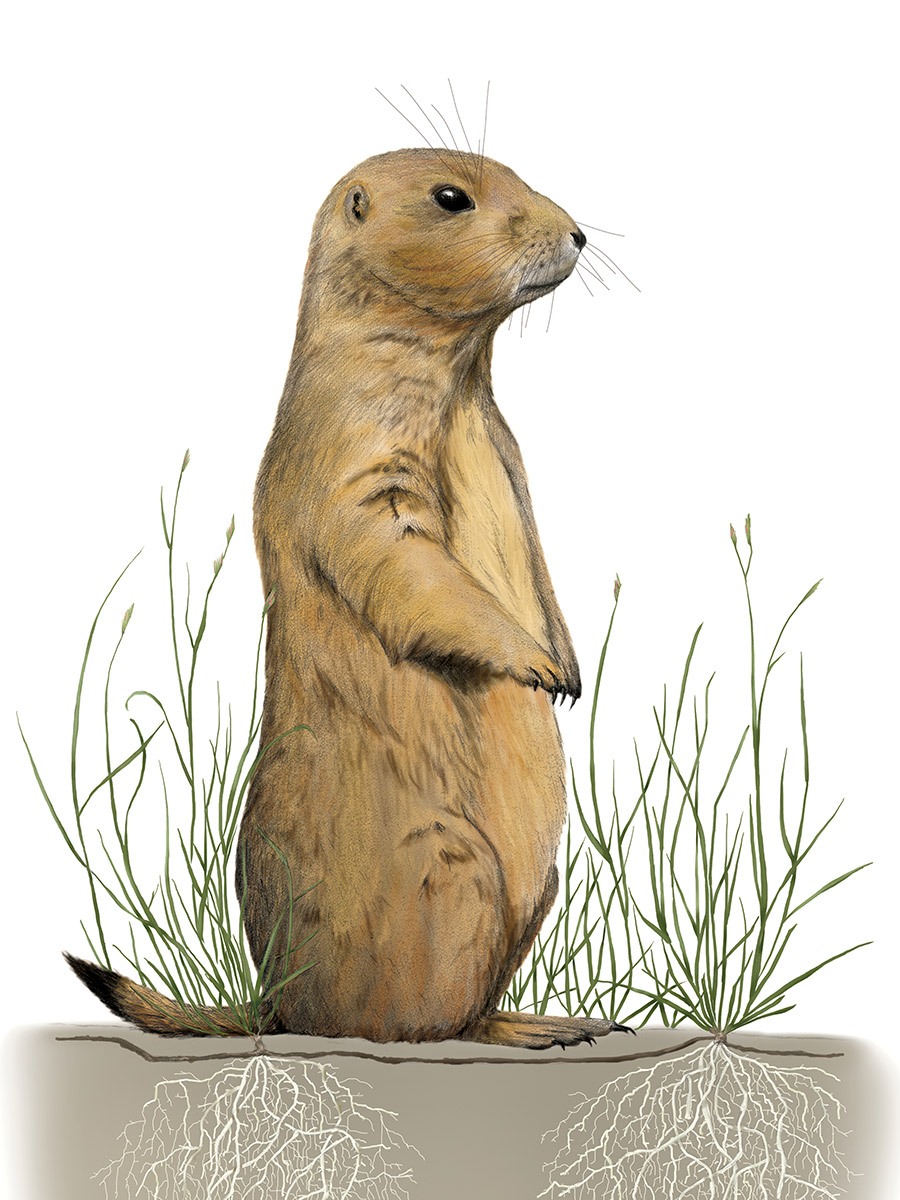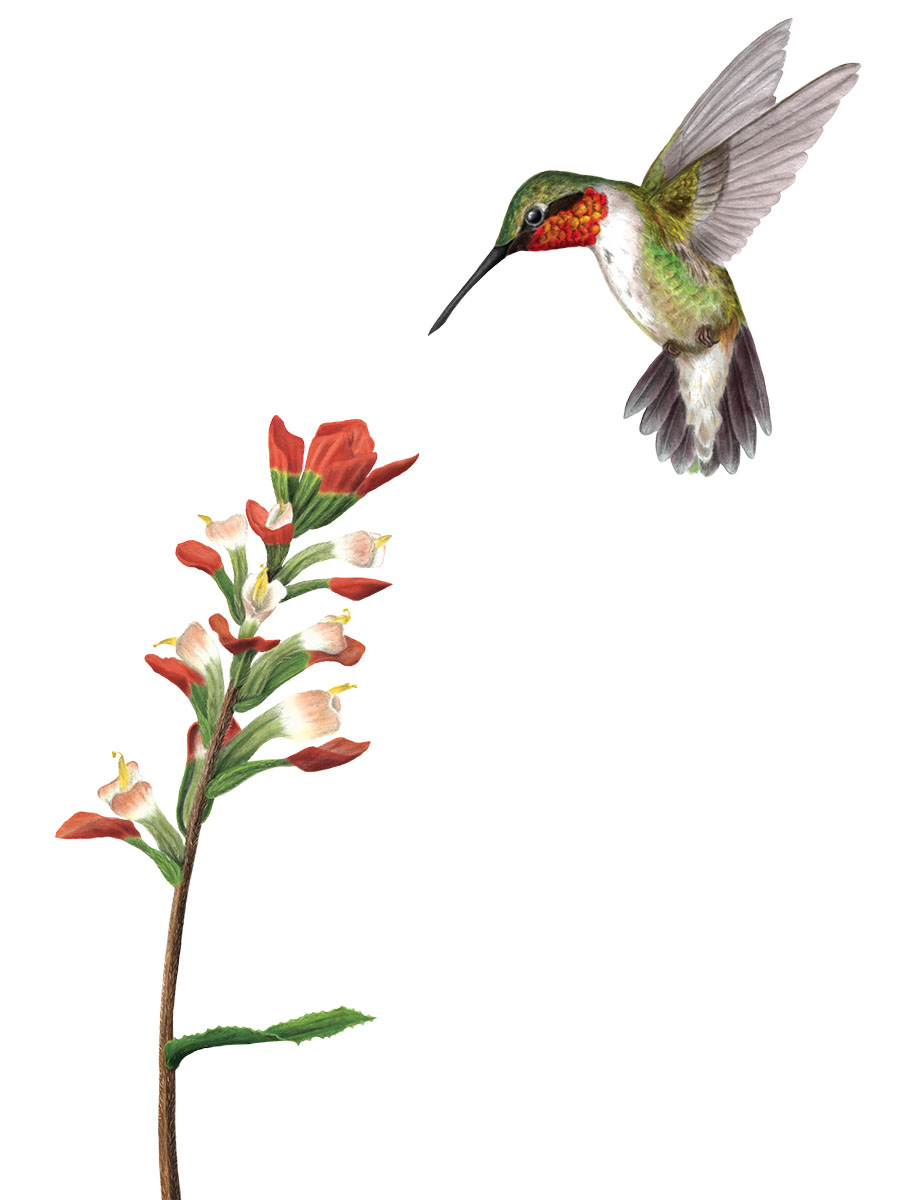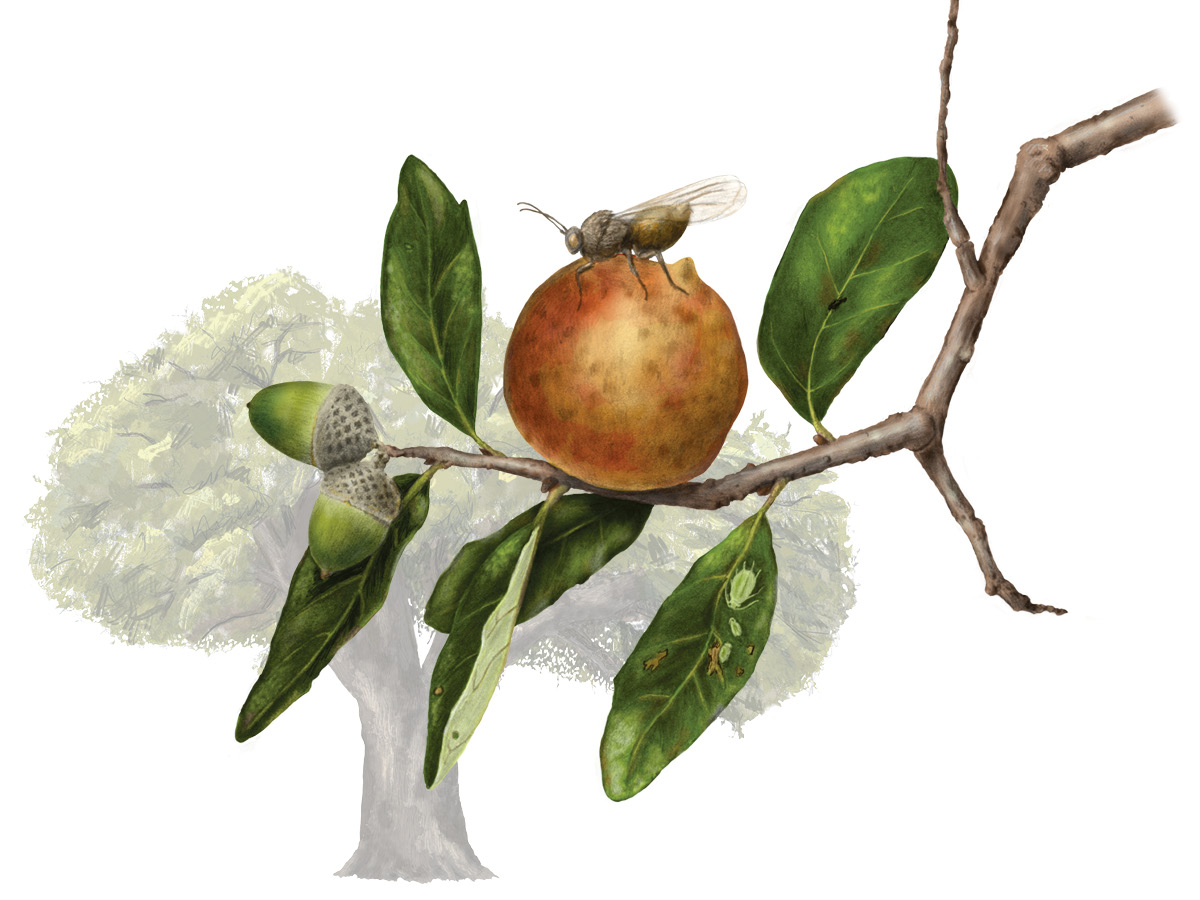Natural Partners

ILLUSTRATIONS Samantha N. Peters
It takes a village, we say. That’s certainly true for plants. The lives of these green, rooted beings are profoundly interwoven with those of other species in surprising ways. Consider these five Texas native plants and the animals that shape their lives.
Tequila and the Big Bang: Agaves and Bats
Imagine you’re a Havard’s century plant (Agave havardiana), your body a spiky rosette of wide, succulent leaves edged with wicked spines. You grow slowly in the dry, rocky mountains of West Texas, storing sugary food you make with the sun’s energy, plus water from infrequent rains. After several decades, you begin feeling the urge to procreate.
There’s only one problem: You’re rooted in place and lacking digits, so you can’t cruise Main Street or head to a bar, much less swipe right on Tinder. What’s a willing agave to do? Enlist a go-between, a partner who can carry your pollen (male sex cells) to the ovaries of others of your kind. Not just any partner, one who can tote pollen long distances and who will be choosy, gravitating toward other Havard’s century plants.
That perfect partner is a nectar-feeding bat. Mexican long-nosed bats (Leptonycteris nivalis), in particular, are capable of winging long distances between banquets. They head north with their young in late winter or early spring, timing their migration to feed from night-blooming desert plants with towering flower stalks and high-octane nectar — including Havard’s century plants.
Agaves attract bats by practicing “big bang” reproduction: they spend their entire supply of sugars and water producing a months-long burst of blooms. In spring, a shoot that looks like a super-sized asparagus stalk spurts up from the center of the plant, branching into flower clusters. The tightly packed, upward-facing yellow blooms are easily visible in low light and emit a musky odor appealing to bats.
These night-flying mammals dive headfirst into each flower, wings flapping, and use their long tongues to swab nectar, fallen pollen and trapped insects for a full meal. As the bat pushes its snout into the flower, the blossom’s sticky stigma picks up pollen clinging to the bat’s fur from previous flowers it has fed from; as the bat pulls away, the anthers dust the mammal with pollen to carry onward. Once the agave has exhausted its stores on a frenzy of blooming and pollination, the plant dies, leaving behind fruits to seed the next generation.
Mexican long-nosed bats pollinate other agave species besides Havard’s, including blue agaves (Agave tequilana), the agave that tequila is made from and which are native to Mexico. Sadly, Mexican long-nosed bat populations are plummeting, perhaps due to vampire-bat control in Mexico and habitat destruction throughout the region. Bat Conservation International also credits this to increased consumption of tequila and mezcal in the U.S. — for liquor production, agaves are harvested before they’ve flowered. Fewer pollinating bats means fewer agave plants, and a fraying of the relationships that sustain desert landscapes and humans alike.

Pitcher Plant Seeks Meat (Insect Meat, That Is)
What causes a plant to turn from producing its own vegetarian food to becoming a meat-trapping carnivore? For yellow pitcher plants (Sarracenia alata), which consume flies and other small insects, it’s the lack of nitrogen in boggy East Texas soils. Plants require nitrogen to make chlorophyll, the compound that converts sunlight into sugary food. Without soil nitrogen, plants turn to other sources — in this case, bugs.
But it’s a bit of a trick for a nonmobile plant to capture insects. Yellow pitcher plants rely on food lures and physics. Their leaves are modified into vertical green tubes with ends folded over into hoods. Flies, ants and other insects are attracted by red and green veins on the leaves that, to insects, appear as directional markers “pointing” into the opening under the hood. They wander inside, nibbling on the nectar droplets the plant exudes. Then physics takes over.
The tube is lined with sharp, downward-pointing hairs that draw the insect in but prevent it from climbing back out; light streaming through the translucent walls confuses prey so it can’t discern the opening. Exhausted, the insects eventually fall to the base of the tube and drown in a pool of liquid there.
Bacteria and other microbes living in the liquid digest the insects, releasing their nitrogen for the plants, much the way our intestinal microbes help digest human meals. And the plants are voracious: Researchers tracking a lovebug (Plecia nearctica) emergence in 1996 found that a bog with about 7,700 Sarracenia plants captured some 2 million lovebugs. That’s 260 lovebugs per pitcher plant — quite a feast!
Yet, some insects have figured out how to use yellow pitcher plant’s deadly tubes as habitat. A few species of mosquitoes lay their eggs in the aforementioned pools. Their larvae feed on the nutrient-rich fluid until they grow large enough to metamorphose, emerging as winged adults able to escape by flying upward, out of the tube.
The pitcher plant mining moth (Exyra semicrocea) takes up residence inside Sarracenia’s tubes. Adult females lay pinhead-sized eggs inside the upper part; after hatching, larvae eat a narrow channel around the inside of the tube so it collapses, forming a protective cap. Larvae then feed on the still-living tissue of the lower portion until they turn into winged moths. Even though the moths can fly away, they don’t readily leave the shelter of the tubes. How the moths find mates and why pitcher plants tolerate moth larvae consuming their insect-trapping tubes are unsolved mysteries.

Why Buffalograss Needs Prairie Dogs
The shortgrass prairie of the western Great Plains is sometimes described as forest turned upside down: above ground, perennial grasses and wildflowers grow knee-high; below, these plants’ roots stretch many feet deep and branch into networks so dense that one square yard of prairie soil may contain 20 miles of roots and root hairs! Take buffalograss (Bouteloua dactyloides), an iconic shortgrass prairie species: Its curling leaves normally top out at 5 inches, yet its roots stretch as deep as 6 feet.
Storing biomass underground in the clement “root cellar” of the soil makes sense for a plant surviving the constant wind and intense sun of North America’s prairies, plus extreme heat in summer and bitter cold in winter. It is also an adaptation to the kind of catastrophic and episodic disturbances that shaped the continent’s seas of grass, says Senior Environmental Designer John Hart Asher of the Wildflower Center. “Prairies are disturbance-driven ecologies,” Asher explains. “They were shaped by natural fire — presettlement, 14 million acres would burn in Texas alone — and by high-intensity, low frequency grazing. Huge herds of plains bison would flood in; munch on grasses and wildflowers; break up the sod with their hooves; poop everywhere, fertilizing the soil; and then move on, not to return for perhaps many years.”
Buffalograss adapted by evolving the ability to resprout from buds buried just below the soil surface, by growing tillers (horizontal stems that form sodlike colonies), and by moving the bulk of the plant underground.
Taking to the soil brings roots in contact with root-munching prairie-dwellers, particularly black-tailed prairie dogs (Cynomys ludovicianus), once the most common mammal on the Great Plains. During the late 1800s, one colony in Texas stretched 250 miles long by about 100 miles wide and contained an estimated 400 million of these vocal rodents! These formerly superabundant mammals have been eliminated in many places due to bubonic plague brought from Asia and poisoning campaigns based on the erroneous perception that livestock and prairie dogs are incompatible.
Wouldn’t prairie dog elimination benefit buffalograss? On the contrary, says Asher. The tunneling munchers are critical to the entire prairie community: Their burrows shelter more than 150 species of prairie animals and insects, from burrowing owls to endangered black-footed ferrets. And the rodents’ feeding directly aids buffalograss by girdling the roots and stems of mesquites and other woody trees and shrubs that would otherwise shade out prairie grasses and wildflowers. Prairie dog tunnels also aerate and fertilize the soil and channel water underground to recharge groundwater, all a boon to the short grass with deep roots.

Paintbrush Eats Poison, Lures Hummingbirds
When seas of bluebonnets (Lupinus texensis) bloom in March and April, they are often accompanied by swaths of coral-red Texas Indian paintbrush (Castilleja indivisa), an annual wildflower whose short life involves relationships with both plants and birds. Texas Indian paintbrush’s story begins with a black seed so small that it takes 4 million to make a pound. That seed sprouts an entire life — growing, producing its neon-bright flower spike, attracting pollinators and maturing seeds — packed into the few short weeks or months before summer’s heat shuts it down.
Texas Indian paintbrush relies on a boost from neighboring plants: When the seed germinates, the baby plant grows lateral roots tipped with “haustoria” as well as ordinary, downward-aiming roots. Haustoria are sensitive tips that sniff out and tap into the roots of paintbrush’s preferred partners, including sagebrush (Artemisia spp.) and blue grama (Bouteloua gracilis) — essentially stealing food and water from the neighbors. According to new research, alkaloids are also part of the loot; these poisonous compounds deter grazers from consuming paintbrush, especially its candy-sweet flower spike. Paintbrush plants containing alkaloids, researchers found, produced more seeds both because more flowers survived to maturity and also because more flowers equaled increased pollination.
The plant’s most effective pollinators are ruby-throated hummingbirds (Archilochus colubris), tiny hoverers who migrate hundreds of miles north from Central America and Mexico just as Texas Indian paintbrush colors the landscape. Hummingbirds cue in on red, tubular flowers that, to them, shout “Food here!”
To attract these long-distance pollinators, paintbrush covers its simple green flowers with signal flags in the form of scarlet bracts. Crowded on dense flower spikes, the bracts blaze brightly, enticing hovering hummers to thrust their brush-tipped tongues behind the bracts and swab up sugary liquid from nectaries at the bases of the flowers. As the birds feed, they leave behind pollen acquired from other paintbrush blossoms.
If ruby-throated hummingbirds’ pollination ensures the survival of new generations of Texas Indian paintbrush, the food the plant provides is just as critical to the fluttering pollinators. “A hummingbird is very expensive to fly,” notes Robert Colwell, evolutionary biologist at University of Colorado Museum of Natural History. If humans had similar energy needs, we’d have to consume a staggering 155,000 calories a day. The nectar’s high water content also helps hummingbirds cool themselves by evaporation.

It Takes a Village: Live Oaks and Oak Gall Wasps
Texas’ most beloved live oak tree may be be escarpment live oak (Quercus fusiformis), with its glossy evergreen leaves and octopus-arm branches shaping trees sometimes wider than they are tall. It’s certainly the most widely planted live oak in Central Texas, where it grows wild in clusters throughout Hill Country.
Escarpment live oaks are notorious for their galls, bumpy growths dotting the dark green leaves and grayish twigs, sometimes so densely that trees look diseased. But galls are actually plant self-defense, nodules that form when something — usually an insect egg, but sometimes fungi, bacteria, nematodes or mites — irritates the plant’s tissues; the plant responds by isolating the irritant within a cushionlike growth.
Some of the most common galls on escarpment live oak form in response to the larvae of mealy oak gall wasps (Disholcaspis cinerosa). The complex life cycles of these tiny wasps are tied to their hosts’ growth: Two different wasp generations hatch from two types of galls, one on live oak twigs, the other on leaf bases.
The longer-lived wasp generation hatches from eggs laid on growing live oak twigs in spring. These larvae secrete chemicals that cause the twigs to grow pinkish, spherical galls up to an inch in diameter. Inside, a Disholcaspis larva dines on the sugary tissue until pupating in late fall. By winter, the adult wasp has chewed out and flown away, and the galls are dry and grey, marked by a neat exit hole.
This twig-gall generation of wasps — all asexual females — lays eggs at the base of leaf buds. The grublike larvae irritate the tree into forming a small, kernel-shaped gall and mature rapidly within it. In only a few weeks, female and male wasps about a third the size of the first generation emerge from these galls and fly off in search of mates. Males die soon after mating while females go on to lay eggs on live oak twigs, starting the cycle again.
Escarpment live oak galls are coveted real estate, feeding and housing a whole community, including wasps that parasitize Disholcaspis larvae, sugar-feeding and scavenger ants, spiders, small flies, bees, butterflies, and larger predatory wasps. The abundance attracts nesting songbirds, which feed their young insects — lots of insects. According to entomologist Douglas W. Tallamy, a single pair of chickadees needs between six and nine thousand insects to raise one brood of young.
As this handful of examples points out, nature is rarely — if ever — simple. Plants rely on animals and vice versa, and those relationships and networks are complex, nuanced, adaptable and endlessly fascinating. Life on earth does take a village or, in other words, an ecosystem; in fact, it takes many of them.
Susan J. Tweit is the author of “Walking Nature Home” and several other books. Learn more and read her work at susanjtweit.com

